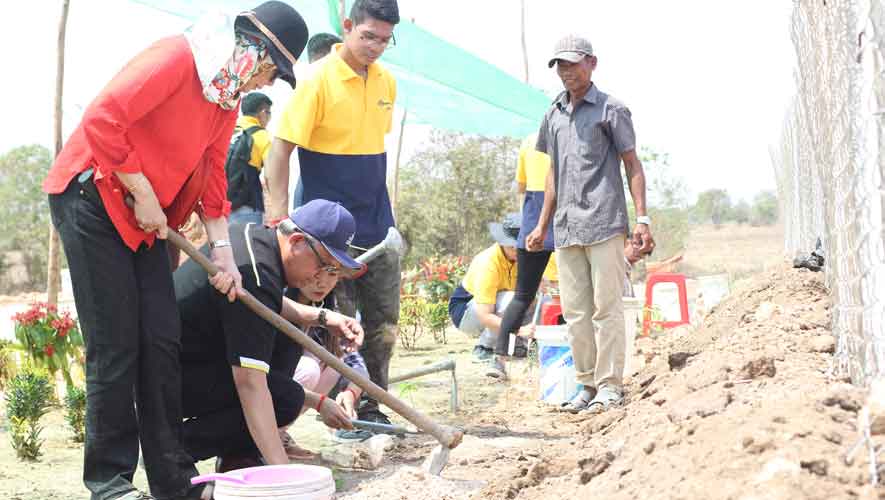The Maybank Foundation and ASEAN Foundation volunteers touched down in Takeo province earlier this month, in a particularly parched, sun-drenched area at the foot of Phnom Chisor. They were in for a rude awakening no amount of training or modules could have adequately prepared them for as part of the select “eMpowering Youths Across Asean” programme.
For the latest Cambodian Business news, visit Khmer Times Business
“Hygiene, comfort, and personal needs” were in short supply according to Farhan Jafar Ali, 22, a student from University of Brunei. “We work without air conditioners, under the sun, food not to our taste, and the cleanliness of numerous objects and properties are questionable.”
“I was sick for two days. I most likely caught a heat stroke from working in the sun,” he adds.
Farhan is part of a diverse nine member group in Takeo taking part in Maybank Foundation’s silk weaving training initiative. The volunteers comprised young people from Brunei, Malaysia, Lao, Thailand, Singapore, Indonesia and Vietnam.
Community projects like these are scaled up as social enterprises across the region. The project receives $20,000 as part of the initiative by Maybank Foundation and ASEAN Foundation with 15 percent or $3,000 of the budget given to its partnered civil society organisation Color Silk Cambodia.
“We partner with Color Silk as an equal collaborator with the same agenda to expand the silk market,” says Muhammad Hidayat Fahmi, a Maybank Foundation programme manager.
Color Silk, founded by Ngorn Vanntha, owns the land while the foundation invests in the infrastructure and programme implementation.
“We know we have to work with local partners in Cambodia,” says Maybank Foundation chief executive officer Shahril Azuar Jimin.
“We always partner with established local partners. It can be for profit or non-profit as long as they are able to provide expertise. We run it like a business, managing it in a way that’s like a small business,” Shahril adds.
According to Color Silk, 80 percent of the silk is exported to the US, Europe and Japan whereas 20 percent is sold locally to tourists.
“Scarves are the biggest seller followed by finished products and fabric,” Vanntha says.

Silk worms to finished products
There are some 290 families growing mulberry trees in the area today. Since the programme’s inception, 42,000 trees have been grown, according to the foundation. The figure is significant given that Takeo has been affected by severe droughts since the 2000s.
“Most of the land in Takeo is idle. Mulberry plantations are water intensive. You actually need a pond to irrigate the plants,” says Shahril.
While mulberry trees can be traced back to the Angkor empire, where kraing, books of literature stored in pagodas, were produced from tree barks, contemporary Cambodian farmers have not taken to growing them commercially after the Khmer Rouge era nearly eradicated the trees. Most have little or no experience of planting or tending to them.
“The industry experienced a very difficult period in the 1970s when it was effectively halted, killing off various aspects of the weaving industry,” Shahril says.
Mulberry trees have a gestation period of five to six months when nothing happens, and an income is not earned during that period.
The programme provides seeds and saplings to the farmers, and instructions on how to care for the trees.
The foundation believes there’s much room for growth in the industry if it is revitalised.
“The silk produced today is only 10 percent of the figures of the 1970s,” Shahril says.
A unique aspect of the programme is that graduates of the six months training program have an option to bring home their looms where they can earn an income without sacrificing their domestic life.
The average income that can be earned is around $120, according to the foundation, adding that the wooden looms cost between $500 and $600.

Bittersweet experience
Last week, the faces of the volunteers were sunburned from digging in the garden behind the training centre. Foundation representatives arrived from overseas to inspect their plans and progress. Perhaps the more lasting impact will be in the lives of the ASEAN volunteers.
“My experience has been bittersweet. The bitter side comes from going out of my comfort zone. I am a city person who is used to a life of shops, convenience and quality,” Farhan waxes poetic.“Takeo became a test of our spiritual strength. As in many things in life, tests come in different forms.”
“Takeo will forever be a guru of many lessons. To which, we foresee will help us vastly in the mysterious future.”
Donald Jae Lee
Business Writer, Capital Cambodia




